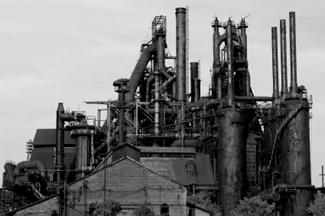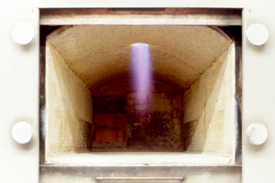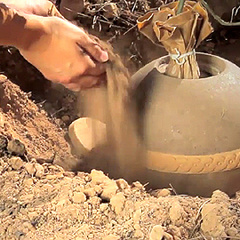The Butterfly Effect
The cornerstone of the modern environmental movement is based around a concept that expresses the importance of taking responsibility for our actions today, in order to ensure that our planet will be a clean and healthy place for future generations. The environmental philosophy, as we know it today, can be traced all the way back to the Industrial Revolution of 18th-century Europe. The Industrial Revolution was a period of major advancement in the areas of agriculture, manufacturing, mining, and transportation, and it had profound effects on the socioeconomic and cultural conditions of Europe, North America, and eventually the rest of the world.
 |
|
Massive fossil fuel-burning factories helped to elevate the standard of living in the West during the Industrial Revolution, but these comforts did not come without a price to the environment.
|
|
New inventions and technology provided new comforts and an increased quality of life for countless people, but all this did not come without a cost. The emergence of huge mass-production factories and the consumption of vast quantities of coal and other fossil fuels gave rise to unprecedented air and water pollution.
The modern environmental movement is loosely related to the butterfly effect, a concept that states a small, seemingly insignificant event can trigger a series chain reactions over time that later results in a major event at a more distant point in the future. The phrase refers to the idea that the fluttering of a butterfly's wings would seem highly insignificant to most people, who are unable to perceive any immediate repercussion or consequence directly related to the flapping of the butterfly's wings. However, since we have a linear perception of time, every single event, both minor and major, will eventually culminate into a ultimate end result. In other words, every outcome is completely and totally dependent on all of the components that make up the system, no matter how big or small. Put yet another way, we simply reap what we sow.
Similarly, if only a small candy wrapper hadn't been thrown out of a car window or if only a few more trees would have been planted at an earlier point in time, perhaps mankind wouldn't later be facing health problems stemming from groundwater pollution or natural disasters possibly caused due to ecological imbalance.
Cremation has been practiced by mankind since prehistoric times and has often been viewed as a more environmentally-friendly form of final disposition. However, like most practices passed down from one generation to the next, modern technology and ecological awareness make it necessary to examine the impact of cremation on the living and our environment.
The Pros
 |
|
Our actions have a direct impact on wildlife habitats around the world.
|
|
As opposed to a traditional casket burial, it is obvious that cremated ashes take up much less space in a cemetery. If the cremains are taken home or scattered, the urn takes up no ground space at all. In some major cities, land for casket burials is so scarce that cemeteries will often require multiple-depth burials, meaning one casket may need to be buried on top of another below ground to conserve space.
Cemeteries decrease the amount of usable land that is available to us, and the clearing and development of land for a cemetery also results in the destruction of forests and natural habitats for wildlife.
Cremation also eliminates the need for embalming. Formaldehyde (or more accurately, formalin) is the primary chemical used to temporarily preserve the body for a public visitation or funeral ceremony, but it is highly toxic to both humans and animals. Although formaldehyde gas is found at low levels naturally, both indoors and outdoors, at higher levels it has been classified a potential human carcinogen. Formaldehyde is used widely in the manufacture of building materials, as well as many household products, so it is used in many other industries outside of funeral service. The short-term health effects to formaldehyde exposure are well known, but prolonged exposure to formaldehyde still requires further study.
The Cons
Despite the many environmental benefits of cremation, there are still some downsides that should also be taken into consideration. The cremation process itself can release harmful chemicals into the atmosphere. However, according to the 2009 EMEP/EEA emission inventory guidebook, it is thought to be less than 1% of the total national emissions of any pollutant, and the total emissions of dioxins and furans is reported to be 0.2%.
 |
|
Modern crematorium retorts are fueled by natural gas or propane.
|
|
Although crematories are highly regulated and must operate under very stringent guidelines in order to minimize air pollution, crematories still release several pollutants into the air including nitrogen oxide, carbon monoxide, and sulfur dioxide. Additionally, hydrogen chloride and hydrogen fluoride can be emitted into the air when chlorinated plastic, a material used in the construction of prosthetic medical devices, is burned.
Mercury is commonly used in conjunction with other metals during dental restoration, and when teeth are burned along with the rest of the body, mercury is released into the air. While there many other industries that discharge much higher levels of mercury into the atmosphere than crematoriums, it is still important to consider the potential downsides when considering cremation.
Crematories also use a enormous amount of energy, utilizing natural gas or propane as fuel. The cremation process can take up to four hours and can only begin after the temperature inside the retort has reached between 1,400 to 2,100 degrees Fahrenheit.
Eco-Friendly Choices
 |
|
Some eco-friendly cremation urns can function as a planter for a living tree or shrub.
|
|
Green burials and memorial nature preserves have become extremely popular in recent years. A green burial is simply an earth burial where the body is interred in a grave with no embalming, no concrete burial vault, and a biodegradable casket, blanket, or shroud is used to enclose the body. Many artisans have taken the "green burial" philosophy and have integrated it into their cremation urns.
Biodegradable cremation urns are made from environmentally-friendly materials and are designed to easily break down naturally over time, eventually releasing the cremated remains back to the earth. Eco-friendly cremation urns can be made from wood, paper, sand, gelatin, and even salt. Some have been designed specifically for water burial. Others are designed to eventually grow into a living memorial in the form of a tree or coral reef.
Alkaline Hydrolysis
Alkaline hydrolysis, a relatively new technology first developed by Western medical schools, is the process of returning the body to ash using a strong base, usually sodium hydroxide, also known as lye. The body is placed inside a large stainless steel tank and a solution of lye is heated to about 300 degrees Fahrenheit.
 |
|
Scientific advancements are being made to ensure the cremation process is more environmentally-friendly in the future.
|
|
The lye is then sprayed onto the body at about 60 pounds of pressure per square inch. The lye chemically hydrolyzes all body tissues, and after about four hours, the body is entirely "cremated" with only fragments of bone remaining, just like with combustion-based cremation. The bone can then be processed by a pulverizing machine, called a cremulator, which produces the cremains.
Alkaline hydrolysis is extremely more environmentally-friendly than the traditional incineration-based cremation method because it creates no air pollution and emits no greenhouse gases. It emits twenty times less carbon dioxide and uses only 10 percent as much energy per body as combustion-cremation. It completely neutralizes all embalming fluids and pathogens, and it produces natural and contaminant-free cremated remains.
Unfortunately, alkaline hydrolysis is still relatively new and cost prohibitive. However, in the next decade, alkaline hydrolysis is certain to become a popular choice simply because of the obvious benefits it offers to the environment over traditional combustion-based cremation.
|